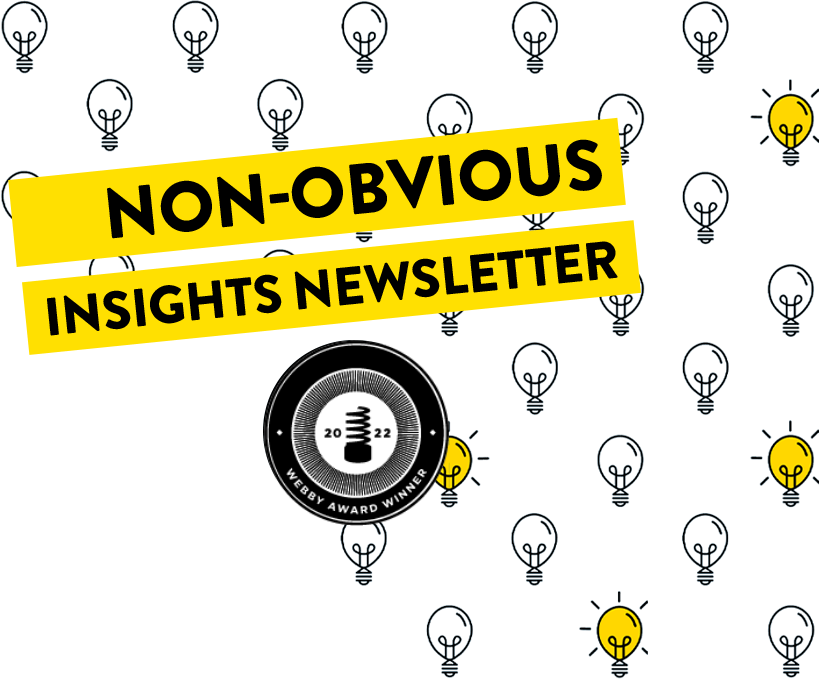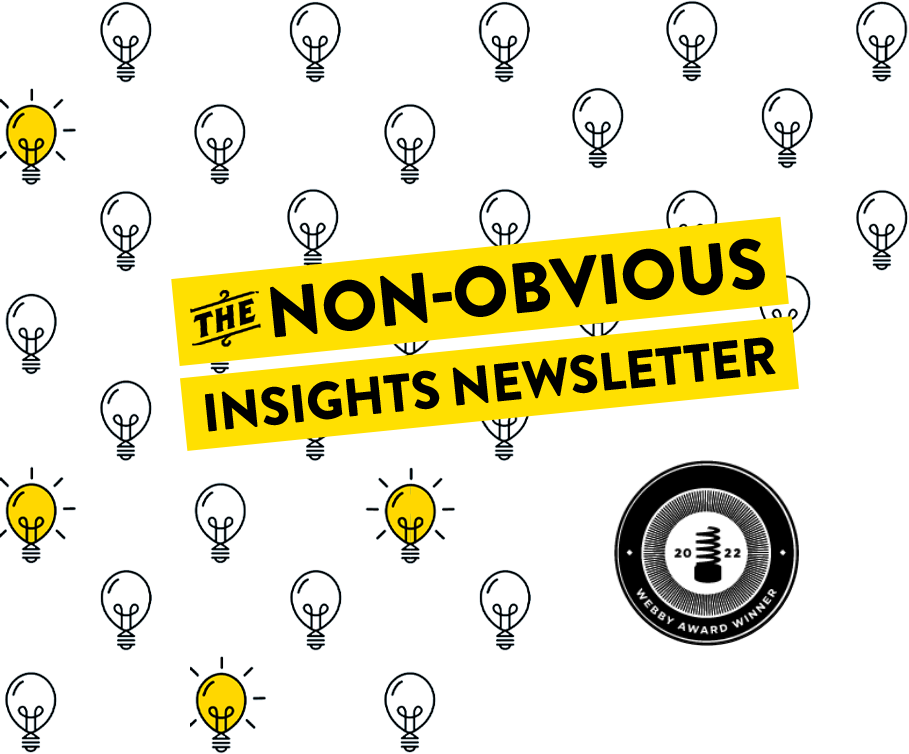Dear Fellow Non-Obvious Thinker,
Last week was the first announcement for SXSW 2026 Keynotes and Featured Sessions and many of you already saw that I’ll be debuting another new talk – and this one will be different from anything I’ve done before: 5 Non-Obvious Secrets of Human Connection (For Love & Profit). I was thinking about it earlier this week, as I was in Austin for another event and looking at the hole in the ground where the Convention Center used to be. It’s a time of reinvention for the city and if you’ll be there for SXSW, make sure to join our list for our big event announcement coming next month. Reinvention is a theme you’ll see in this week’s newsletter too.
In stories below, we explore the evolution of Pittsburgh from the home of the steel industry to its ambitions for becoming a hub for physical AI and robotics development. You’ll also read about Ring’s ambitions to create zero crime neighborhoods, lessons about the nature of villainy from Pre-K TV shows, how Reddit is fighting back and why everything from perfume to soap smells like food now.
Enjoy the stories and stay curious!
Lessons From the Reinvention of Pittsburgh into an AI Robotics Hub
Pittsburgh was known for steel. Now the city has ambitions to become a hub for something else: AI and robotics. The pieces seem to be falling into place. From central robotics labs at the University of Pittsburgh and Carnegie Mellon to investment from the city, the ecosystem is being built right now as this feature article notes. The most interesting part of this evolution, though, is how the early evangelists for telling this story seem to be linking it back to the roots of Pittsburgh’s identity as a city too.
As managing director of Carnegie Mellon’s Swartz Center for Entrepreneurship Meredith Meyer Grelli says (while brilliantly throwing some shade in the direction of San Francisco), “we’re not a land of dating apps … we figure [stuff] out that makes the world a better place to be in.” The Robotics Institute at Carnegie Mellon, for example, is focused on building robots that are trained to use artificial intelligence to do everyday tasks like hanging clothes or doing dishes.
The robots are examples of something called physical AI: essentially, robots that use artificial intelligence to perceive their environment and make decisions with some degree of autonomy. The university sees physical AI as a technological frontier where it can plant a flag – and it’s doing this work in a building that carries echoes of Pittsburgh’s industrial past.
In 2024 the region saw $999 million in VC investment (I guess no one could find someone to throw in the last million to hit that $1B mark). This year, the investment is set to grow and the mindset of those building these new technologies is focused on this frontier of physical AI. It’s a lesser told story amongst all the things we generally read about the explosive growth of generative AI tools, but it can arguably be significantly more impactful for most people’s daily lives. And if someone is going to emerge as the leader, why not Pittsburgh?
Can The Ring Camera Eliminate Neighborhood Crime In 12 Months?
Thanks to advancements in AI and the ubiquity of the Ring household doorbell cameras, Ring CEO Jamie Siminoff believes we might be twelve months away from his cameras being able to “almost zero out crime.” It’s a bold claim, but there’s a possibility it may not be as far-fetched as it seems. He’s currently on a book tour and this sort of bold pronouncement is a great media hook (so kudos to his PR team on that one) but unpacking how Ring might get there is truly an interesting story.
Their cameras are widely used not just for the doorbell cameras, but as video surveillance and security across neighborhoods. When you have that sort of coverage, some futuristic possibilities start to become reality. Lost dogs could be quickly returned to owners because the video grid could more easily locate them. Front door package thieves, a persistent problem in many regions, could be reduced or eliminated. Home invasions would become much more difficult and impossible to get away with by less sophisticated criminals.
In respect to the obvious security and privacy questions that having such a neighborhood grid built on technology owned by an Amazon company might create, Siminoff offers a practiced answer:
“Siminoff dismisses what he calls “misinformation.” He firmly believes that technological security and personal privacy can coexist, describing police requests for voluntary video footage as a non-controversial practice. Privacy advocates and civil rights organizations strongly contest this position, warning about the dangers of creating extensive private surveillance networks.”
Altogether, the biggest question the story raises is what are people willing to give up for the promise of a zero-crime neighborhood? If online behavior is any guide, personal privacy often comes second when other benefits enter the picture. It’s likely that the same people willing to trade their personal data for access to a social platform they don’t need to pay for will happily make the choice to connect their doorbells to the grid and help make Ring’s vision a success.
The Villains on Pre-K TV Are Cuddly, Annoying and Onto Something Interesting
How does the evolution of the way we learn to see “bad guys” evolve as we grow older? That was the interesting question at the heart of a story from the New York Magazine this past weekend. It’s a question I recall thinking about when my kids were younger and there was a moment when we saw a character with a Russian accent on a show and my son immediately assumed he was the bad guy (which he wasn’t). I realized that in many of the shows he had seen, the bad guys did indeed have some sort of menacing Eastern European accent.
Beyond accents or stereotypes, the way bad guys are either rehabilitated (in Pre-K shows) or roundly defeated and exiled (or killed) in programs aimed at older audiences does demonstrate a fascinating shift in how we learn about morality and right and wrong.
This narrative formula will be familiar to almost anyone who cares for a prekindergarten television viewer. Somebody does something antisocial. The heroes get the call. Action unfolds. The villain, it emerges, did what he did for sympathetic reasons, in childlike ignorance of the harm it would cause. The heroes deliver a stern but kind admonishment and a concise moral lesson. The villain understands and apologizes. Everything is mended and at peace.
This is a striking change from broadcast and even cable TV, which featured a much more limited number of shows made for this audience. The child-friendly superhero shows they did offer, like “Batman: The Animated Series” or “Power Rangers,” were aimed at a slightly older crowd — and their villains had little motivation beyond a sick desire to subjugate all of humanity, or steal big cloth bags of cash, or wreak havoc for havoc’s sake. Those villains were either incarcerated or, occasionally, blown up; that was what you did with Bad Guys.
The point the article makes is that we do lose something in these adult themed shows that depict evil doers as simply choosing the so-called dark side because they are motivated by profit or power or simply just a need to bring chaos as a way to disrupt the world’s order. These shows, though more complex, may indeed “manage less insight into the nature of wrongdoing than the average preschooler is exposed to.”
The Non-Obvious Media Recommendation of the Week
To Dine For Podcast with Kate Sullivan
Journalist Kate Sullivan asks entrepreneurs and innovators to share their favorite restaurant, and then they travel there together to share a meal and then record a conversation. Her candid conversations around food, life and inspiration are done in a non-obvious format as she reminds listeners just how much we all have in common if we choose to share a meal with one another. To Dine For – The Podcast is a traveling show that spotlights interesting people and restaurants in an unusual format. For those reasons, this is an entertaining podcast to add to your listening routine.
The Non-Obvious Book of the Week
Toxic Positivity by Whitney Goodman
If you’re an optimistic person, it’s possible that you’re part of the problem. We often feel like being positive and having the right mindset is an imperative part of happiness, but this book introduces the counterintuitive idea that there can indeed be too much of a good thing. When you always frame moments in the positive, you don’t allow space for reality or the upside of negative thoughts:
Toxic positivity is the advice we might technically want to integrate but are incapable of processing at the moment. Instead, it typically leaves us feeling silenced, judged, and misunderstood … somewhere along the way, we constructed this idea that being a “positive person” means you’re a robot who has to see the good in literally everything. We force positivity on ourselves because society tells us to, and anything less is a personal failure. Negativity is seen as the enemy, and we chastise ourselves and the people around us when they succumb to it. If you’re not positive, you’re simply not trying hard enough. If you’re not positive, you’re a drag to be around. Healthy positivity means making space for both reality and hope. Toxic positivity denies an emotion and forces us to suppress it.
As the author argues, sometimes toxic positivity just manifests as denial, and you end up failing to face the world as it is. The solution may be to abandon the always positive mindset and instead allow for a wider range of emotions. Too much negativity or too much positivity can both be toxic. This book is an essential guide for how any of us can be a better person, parent, friend or colleague by allowing more space for reality … even when it may not be so positive.
About the Non-Obvious Book Selection of the Week:
Every week I share a new “non-obvious” book selection. Titles featured here may be new or classic books, but the date of publication doesn’t really matter. My goal is to elevate great reads that you might have otherwise missed.
Even More Non-Obvious Stories …
Every week I always curate more stories than I’m able to explore in detail. Instead of skipping those stories, I started to share them in this section so you can skim the headlines and click on any that spark your interest:
- Why Everything from Perfume to Soap Smells Like Food Now
- Colleges Face a Reckoning: Is a Degree Really Necessary?
- ChatGPT Usage Has Peaked and Is Now Declining, New Data Finds
- The Social Media Trend Machine Is Spitting Out Weirder Results
- Reddit Sues Perplexity and Others Over Data Scraping to Train AI System
How are these stories curated?
Every week I spend hours going through hundreds of stories in order to curate this email. Looking for a speaker to inspire your team to become non-obvious thinkers through a keynote or workshop?
Watch my new 2025 speaking reel on YouTube >>





